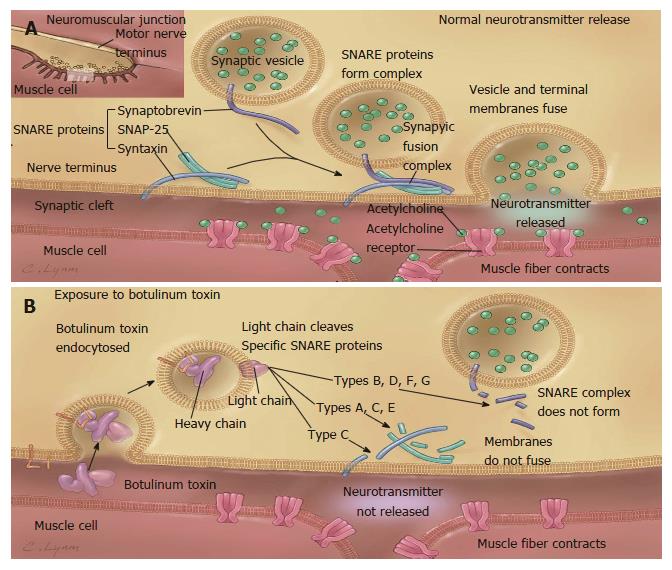Copyright
©The Author(s) 2015.
World J Gastrointest Pharmacol Ther. Nov 6, 2015; 6(4): 145-155
Published online Nov 6, 2015. doi: 10.4292/wjgpt.v6.i4.145
Published online Nov 6, 2015. doi: 10.4292/wjgpt.v6.i4.145
Figure 2 Mechanism of action of botulinum neurotoxin.
A: Release of acetylcholine at the neuromuscular junction is mediated by the assembly of a synaptic fusion complex that allows the membrane of the synaptic vesicle containing acetylcholine to fuse with the neuronal cell membrane. The synaptic fusion complex is a set of SNARE proteins, which include synaptobrevin, SNAP-25, and syntaxin. After membrane fusion, acetylcholine is released into the synaptic cleft and then bound by receptors on the muscle cell; B: Botulinum toxin binds to the neuronal cell membrane at the nerve terminus and enters the neuron by endocytosis. The light chain of botulinum toxin cleaves specific sites on the SNARE proteins, preventing complete assembly of the synaptic fusion complex and thereby blocking acetylcholine release. Botulinum toxins types B, D, F, and G cleave synaptobrevin; types A, C, and E cleave SNAP-25; and type C cleaves syntaxin. Without acetylcholine release, the muscle is unable to contract. SNARE: Soluble NSF-attachment protein receptor; NSF: N-ethylmaleimide-sensitive fusion protein; SNAP-25: Synaptosomal-associated protein of 25 kD. Reproduced with permission from Arnon et al[91].
- Citation: Nassri A, Ramzan Z. Pharmacotherapy for the management of achalasia: Current status, challenges and future directions. World J Gastrointest Pharmacol Ther 2015; 6(4): 145-155
- URL: https://www.wjgnet.com/2150-5349/full/v6/i4/145.htm
- DOI: https://dx.doi.org/10.4292/wjgpt.v6.i4.145









